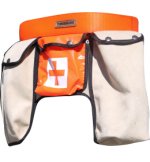arrow
Super Member
Lot of info here, and some pointless arguing. I actually only got in about two hours of work this weekend before the chainsaw decided to quit. Somebody mentioned 2 saws is a good idea, but I've only got one, soooo, I found some alternate projects until the saw gets fixed.
I have cut hanging trees and trees under tension, so I know what released trees can do. That's why I was so wary going into my first time cutting full sized hung trees. most of my short time sawing Saturday was getting a big tree top down on the ground. It had snapped 15 ft up the trunk and the top was on the ground, and the trunk resting on top of the 15 ft stump. I was able to get it down by careful cutting of the top branches. Once the whole mess was on the ground, the saw stopped cutting and so the tree's still down.
As to the video posted, cutting over by head like that isn't going to happen, and that seems a little to dangerous to try. If the trunk slides the wrong way, curtains for the operator. One thing I've learned is that trees can be unpredictable when they fall, or at least very hard to judge correctly.
TJ if this ever happens again, you can get it down and not bother with the top first. The key is to think the tree is still up. You would fall this tree either to the left or right perpendicular to the break depending on the tip (meaning lean) of the trunk and or weight side characteristic of the break. Notch it, cut it leaving the traditional hinge and either push it or pull it over with the CK depending on size of tree. What this does is relieve a lot of the tension on crown branches and unsprings many of them when the entire tree is lying on the ground. Your next cut should separate the crown from the trunk making it a bit safer to cut up the crown.

